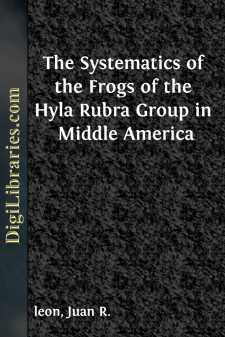Categories
- Antiques & Collectibles 13
- Architecture 36
- Art 48
- Bibles 22
- Biography & Autobiography 813
- Body, Mind & Spirit 142
- Business & Economics 28
- Children's Books 17
- Children's Fiction 14
- Computers 4
- Cooking 94
- Crafts & Hobbies 4
- Drama 346
- Education 46
- Family & Relationships 57
- Fiction 11829
- Games 19
- Gardening 17
- Health & Fitness 34
- History 1377
- House & Home 1
- Humor 147
- Juvenile Fiction 1873
- Juvenile Nonfiction 202
- Language Arts & Disciplines 88
- Law 16
- Literary Collections 686
- Literary Criticism 179
- Mathematics 13
- Medical 41
- Music 40
- Nature 179
- Non-Classifiable 1768
- Performing Arts 7
- Periodicals 1453
- Philosophy 64
- Photography 2
- Poetry 896
- Political Science 203
- Psychology 42
- Reference 154
- Religion 513
- Science 126
- Self-Help 84
- Social Science 81
- Sports & Recreation 34
- Study Aids 3
- Technology & Engineering 59
- Transportation 23
- Travel 463
- True Crime 29
The Systematics of the Frogs of the Hyla Rubra Group in Middle America
by: Juan R. leon
Description:
Excerpt
Introduction
The tree frogs of the Hyla rubra group are abundant and form a conspicuous element of the Neotropical frog fauna. Representatives of the group occur from lowland México to Argentina; the greatest diversity is reached in the lowlands of southeastern Brazil (Cochran, 1955). The group apparently originated in South America; the endemic Central American species evolved from stocks that invaded Middle America after the closure of the Colombian Portal in the late Pliocene.
Dunn (1933) partially defined the rubra group as it occurs in Central America. Cope (1865, 1876, 1887), Brocchi (1881), Boulenger (1882), Günther (1901), Noble (1918), Kellogg (1932), Dunn and Emlen (1932), Stuart (1935), and Gaige (1936) dealt with the Middle American species now considered to make up the rubra group. More recently, Taylor (1952, 1958), Fouquette (1958), Starrett (1960), and Duellman (1960, 1963, 1966a) studied aspects of the taxonomy and biology of the species of this group. The five species of the rubra group in Central America have received ten different names. One species, Hyla staufferi, has received five names (two subspecies are recognized herein). Hyla boulengeri was named in the genus Scytopis, but the type species of Scytopis is a member of the genus Phrynohyas Fitzinger, 1843 (Duellman, 1956.)
Little has been published concerning the ecology, life history, osteology, and mating calls of the Middle American species of this group. The purpose of the present report is to describe the species occurring in Middle America and to comment on their distributions, ecology, cranial osteology, and mating calls, and in so doing provide evidence for the evolutionary history of the species inhabiting Middle America.
Acknowledgments
For permission to examine specimens in their care, I am grateful to Drs. Richard G. Zweifel, American Museum of Natural History (AMNH); Robert F. Inger, Field Museum of Natural History (FMNH); Ernest E. Williams, Museum of Comparative Zoology (MCZ); Hobart M. Smith, University of Illinois Museum of Natural History (UIMNH); Charles F. Walker, University of Michigan Museum of Zoology (UMMZ); Jay M. Savage, University of Southern California (USC); James A. Peters, United States National Museum (USNM); Richard J. Baldauf, Texas Cooperative Wildlife Collection (TCWC); and W. Frank Blair, Texas Natural History Collection (TNHC). KU refers to specimens in the Museum of Natural History, University of Kansas. For the loan of tape-recordings of mating calls I thank Drs. W. Frank Blair, University of Texas, and Richard G. Zweifel, American Museum of Natural History.
I am indebted to the Ford Foundation-Universidad de Oriente (Venezuela) Science Project for a scholarship which enabled me to study for two years at The University of Kansas, foster institution of the project. I have benefited by being able to work in the Museum of Natural History at The University of Kansas and I am grateful to Dr. E. Raymond Hall, Director, for providing space and equipment....


